The sun is the source of all energy on earth except for geothermal and nuclear energy. Even fossil fuels are the product of ancient solar energy. We can feel this energy very directly when we sunbathe and are warmed by the sun. We are also using this direct energy all the time in our homes as it warms the building fabric and as it enters through windows and becomes trapped by the greenhouse effect (in its original meaning). This use of solar energy is called passive solar energy, since no mechanism is used to enhance or collect it. Active solar energy, on the other hand, uses special collectors, of which there are two main types: fluid collectors, which heat a fluid circulated within them, and photovoltaic cells, which convert light energy to electrical energy. Both of these active ways of harnessing solar energy will be discussed first.
ACTIVE SOLAR ENERGY
Solar Water Heaters
Over the past two decades, there have been many different types of solar water heater installed in Britain and the US. Unfortunately, very few of the early models worked with any degree of satisfaction, and many members of the public have been sold systems that cost hundreds and sometimes thou sands of pounds but that resulted in no appreciable savings in their overall energy expenditure.
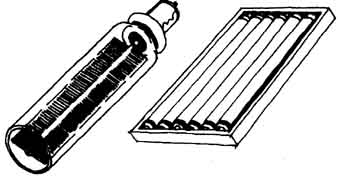
Solar collectors
In the UK it is only worth using the most advanced and efficient systems to take particular advantage of the summer sun to provide hot or warm water, so that the main boiler can be turned off. The same holds true for many parts of North America, where a solar water heater seldom supplies 100% of a household’s hot water needs. In general (though not invariably), southern regions will provide considerably better returns than northern ones. Where the total amount of heat collected is small, the most successful method of using this heat is to preheat the water in the hot water storage cylinder, so that less energy is expended in bringing it up to the required temperature.
The way in which the most advanced existing solar collectors work is to collect the heat in vacuum tubes similar to those used in fluorescent light fittings. This reduces the heat loss considerably. In some of these heaters the back of the tube has been silvered so that light and heat are focused onto another long, thin, blackened tube containing water or oil at the center. Others simply use an absorbing metal plate with the liquid similarly running down a tube in the middle. This second type is more suitable for overcast skies and so is most commonly used in Britain. The heat in the inner pipe is transported away by a liquid medium to a calorifier or heat exchanger, usually inside a hot water cylinder or in a preheating cylinder.
A second type of collector, which is more commonly used, is the flat plate collector, consisting of a metal absorber plate to which tubes containing the heat transfer fluid are bonded. The absorber plate is placed on a layer of insulation, and the whole thing is put inside a box with a glass or plastic lid.
If you have a large enough area of these collectors, it is possible to obtain all your hot water needs during the summer and a considerable proportion of your autumn and spring needs. This will depend on your having a suit able roof (or equivalent inclined location) facing roughly south, and with enough surface area to accommodate the number of collectors you require. The main problem is that installing a really efficient system is still relatively expensive. Generally, the most energy-efficient plan is to complete all your energy-conserving measures first before investing in solar water heating. However, if electricity is your only means of heating, then fitting solar collectors certainly makes sense.
Orientation and Mounting of Collectors
The optimum panel size for an average household is about 30 square feet: a larger collector area will of course provide more hot water, but not so cost- effectively. It is important when mounting a collector to watch for obstructions such as buildings or trees; the panel should ideally face no more than 45 degrees from due south (that is, facing as far as southwest or southeast, but not beyond). For optimum solar collection over the whole year, the collector should be tilted at an angle of about 35 degrees to the vertical. Care should be taken with the mounting of the panel so that the weight is supported by the rafters. A low power-pump is used to transfer the heat from the panel to the hot water cylinder, and a differential temperature controller is used to turn the pump on when sufficient solar heat is available to heat the tank. It is important to install this equipment properly, as otherwise much energy can be wasted. Neither building inspector nor zoning board approval is usually required to install a solar water heating system, but it is worth a phone call to check with your local authorities.
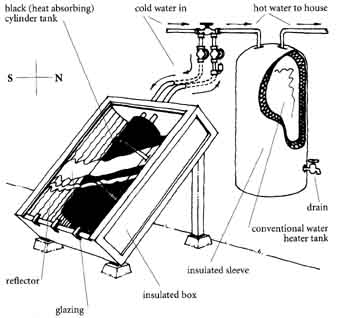
A batch water heater incorporates a passive solar
collector/storage tank that preheats water and reduces the energy used
by the conventional water heater. black (heat absorbing) cylinder tank;
cold water in; hot water to house; conventional water heater tank;
glazing
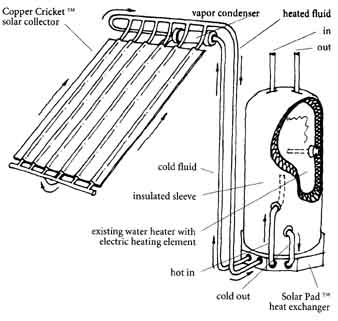
The Copper Cricket is one brand of solar hot water
system that uses a collector plate on the roof and a storage tank inside
the house. Depending on season and location, the system can be used either
by itself or to preheat water for a conventional system. solar collector;
existing water heater with electric heating element; cold out; Solar
pad heat exchanger
Photovoltaic Cells
Photoelectric (or PV) cells are based on a wafer or ribbon of semiconductor material, usually silicon. One side of the semiconductor material is electrically positive (+) and the other side is negative (-). When light strikes the positive side of the solar cell, the negative electrons are activated and produce an electric current. When a group of solar cells are connected, a solar module is created which then produces a higher voltage than just a single cell. The cells are encapsulated under transparent material and the total electrical output is determined by the number of cells that are connected together within a module. Modules can be further linked in a panel to form a solar array.
The efficiency of most standard crystalline silicon cells is about 13%, which means that 13% of the energy in the incident light is converted into electricity. A photovoltaic cell converts light into DC (direct current) electricity. They have become common in powering calculators and watches that require very small amounts of current and have proven to be reliable electrical power producers in thousands of terrestrial and space applications. There are continuing developments in photovoltaics with many possibilities for future developments in domestic energy applications. It is conceivable that windows themselves, or even south-facing walls and roofs, could someday be used as solar cells.
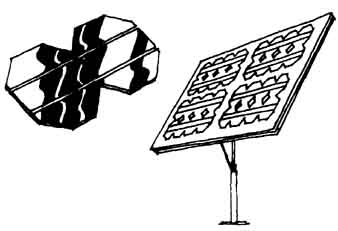
A photovoltaic cell and array
For the present, however, the same can be said of photovoltaic cells as for solar water heating: that for the equivalent expense you can probably save far more energy by undertaking other energy-conserving measures first. Their expense precludes them from being a first-priority installation in most people’s homes. Their use at present is particularly appropriate in isolated, off-the-grid locations and in applications (like low-level outdoor lighting or electric fence charging) where small amounts of power are required.
PASSIVE SOLAR POWER
The principle of passive solar power is very simple in its most common form. Light energy enters through glass, which is transparent to visible wavelengths (as we know, because we can see through it). This light energy is transformed into heat when it is incident on the interior of the room. Once this heat is reradiated from the surfaces within the room, its wave lengths are longer and the glass, acting like a mirror to these longer wave lengths, reflects most of the heat energy back into the room.
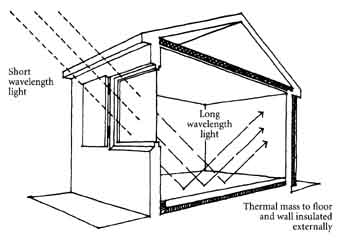
Passive solar gain: Thermal mass to floor and wall insulated externally; Short wavelength light
If we want to make the most of this heat and keep it from dissipating too quickly, there are four main things we can do:
• Insulate the external walls, ceiling (or roof), and floor of the building in which we wish to contain heat (see INSULATING section).
• Install double-glazing and use low-emissivity (low-E) glass in windows to reflect even more of the heat back into the room.
• Increase thermal capacity if necessary: if your home is not constructed of heavy materials, such as bricks or concrete, that have a high thermal capacity to store and even out the heat, then it maybe worth introducing some thermal mass within the insulated envelope. (Columns or drums of water contained in glass have been used effectively, as have dark-colored, sun-facing masonry surfaces built behind glass—known as Trombe walls.)
• Cover the windows at night with insulating shades or shutters to reduce heat loss.
Any window can thus become a solar collector; even north-facing ones can become collectors during daylight hours if the insulation levels are high enough in the window through which the light passes.
It is important to realize that in Britain we are placed further north than we often perceive ourselves to be, because of the warmth of the Gulf Stream. The majority of the country is between 51 and 58 degrees north latitude, which puts us on the same latitude as Denmark, Canada, and mid-Russia.
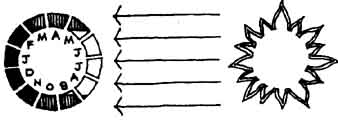
Incident solar energy through the months
The US, where solar energy is more used and more research has been done, is much further south than in Britain. Our comparatively northerly latitude means that we receive very little energy from the sun in the middle of winter, especially in northern Britain. November, December, January, and the first half of February are all low solar-energy months. These are the months when draft-proofing and insulation are all-important, and when we almost certainly have to use top-up heating to keep our homes warm.
However, if we think of the months of spring (the second half of February, March, and April) and autumn (September and October), this is when we may be able to avoid using heating or reduce it considerably if we make the most of passive solar energy during this time. Another name that is given to the light energy that enters our houses, straight from the sun into our living rooms, is direct gain.
Windows and Roof-lights
Windows are the most important element on the facade of a house. They give a house character. They are like the eyes through which we can look out and , as we have seen, it is this same property that allows the sun’s energy to pass through the glass and into the house. Windows that face south, south east or southwest receive the most sunlight throughout the year and even more is collected by an inclined south-facing roof-light or skylight.
Dormer windows provide yet another opportunity for passive solar gain. A feature that is something between a roof-light and a standard window, dormers often have the advantage that they are high up on the house and miss the possible shading from nearby buildings and trees.
In closely built-up urban areas, it is often difficult to achieve sufficient solar gain from downstairs windows. Besides this, solar energy falls at its most intense on an inclined roof. In most houses this energy remains unused, and it is worth considering ways of using it. Besides installing solar collectors, there is the possibility of creating a rooftop garden, greenhouse, conservatory, or sunroom. Some of these will require considerable redesign to incorporate and , of course, this will not be possible for some houses. However your roof remains a potential area for development—a place to have fun and be creative with design.
For most houses, it is questionable whether it is worth extending windows or building new ones on the main facade of the house for the sole purpose of collecting solar energy, even on the south side. However, since roof-lights (especially skylights) are relatively cheap, they may present you with your best opportunity to improve the contribution that passive solar gain makes to the heating of your home.

Windows, roof lights, and over-shading
Night-Time Insulation
The importance of insulating windows at night has already been mentioned.
This subject is dealt with in the INSULATING section of this guide.
Solar Room Addition
If you are thinking of extending the interior space in your house on the southern side, you would do well to consider adding on a solar room. We have already mentioned the use of your roof space for this purpose, since it may be the only place available to you with enough sun. If you are serious about collecting and storing heat in a south-facing sunspace, then you need to think about how the heat from this room can be transferred to other parts of the house. Thermal storage is probably difficult to achieve in your roof space, as it will very likely suffer from a general lack of thermal capacity. It maybe worth thinking of dissipating some of the excess heat with a length of ducting and a fan, and depositing it elsewhere in the house where it is actually needed.
A solar room can be made by converting or extending an existing porch, by carefully building an addition onto the side of your house (see the EXTEN SIONS section in Part One), or by glazing over part of your roof. The type of solar room that is best for you depends on just what you plan to use it for. There are two basic ways to use one:
1. As a Sunspace
Your solar room can simply be a warm, sunny place to sit during the day or a play space for children. If you are at home in the daytime, you can turn down the thermostat in the main house to save energy when is warm enough to use. If your sunspace is connected to the house, the heat can be channeled into the main part of the house and closed off again when the sunroom cools off. You can wire a fan to the thermostat so that it turns on automatically when the temperature in the solar room reaches a certain level. A more sophisticated way of doing this is to cut two vents in the wall separating the solar room from the rest of the house, one high on the wall near the ceiling and one down near the floor. Install a fan in the top vent to blow heated air into the house. Cooler air will return to the solar room naturally through the lower vent. Circulating solar-heated air through the house reduces the need for heating and shortens the heating season. Best of all is to install a duct to carry heated air to the north side of the house. Unless this is done, the sunroom will almost certainly be too hot at times.
2. As a Growing Space
If the primary purpose of having a solar room is to produce food, flowers, or air- or water-cleaning plants, you should think of it as a solar green house. You need to make sure that it can retain enough of the heat collected during the day so that the temperature doesn’t fall below freezing at night. This can be done by adding thermal mass to store up heat (a masonry wall or floor, for instance) or by using night-time insulation (curtains, blinds, or pop-in panels) over the glass to reduce heat loss. What makes a green house a solar greenhouse is that, with proper design, it takes little or no supplemental heat to keep its ambient air temperature above freezing throughout the winter.
For many people, the fuel savings from the attached solar room are less important than the amenity value and increased value of the home. The basic idea is that a good design will give you a room that doesn’t cost you anything to heat. and a very good design and proper distribution of heat will actually reduce your home heating costs.
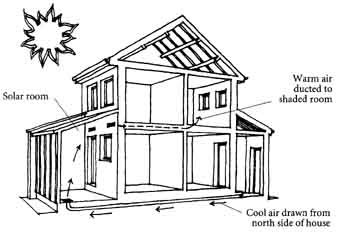
Solar room used to warm cooler parts of house:
Solar room; Warm air ducted to shaded room; Cool air drawn from north
side of house
PRIORITIES FOR ACTION
• Consider the use of solar collectors for water heating. There are two main circumstances in which it makes sense: (a) if you have already fulfilled the most important energy-conserving measures and are looking to take further steps; or (b) you have an inefficient method of heating your water in summer, such as by electricity (see WATER HEATING at the beginning of this section).
• Maximize the potential your house has for collecting passive solar energy. This can be done by: (a) making the best use of your existing windows and the best use of rooms that receive the most sun, particularly in the spring and autumn; and (b) ensuring that as little as possible of this energy escapes at night, by insulating your windows with fitting curtains, blinds, shutters or pop-in panels.
• Harness solar energy by adding a solar room or conservatory in your roof space, or by building in an oriel window upstairs. Alternatively, you can build a south-facing conservatory or sunroom onto the house. If you carry out one of these projects, it is important to be clear about its main purpose (growing plants, supplementary heating, etc.) so that it can be designed accordingly.
Next: Health: Toxins and Pollutions
Prev: Appliances